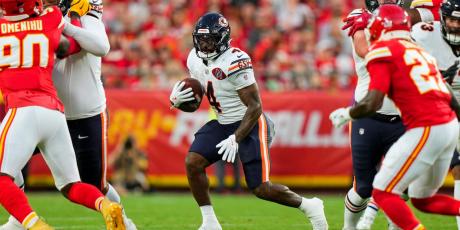John Paulsen's 2020 Draft Day Strategery

We’re about in the middle of August, so it’s once again time for me to outline how I’m going to approach fantasy drafts this year. I have participated in a number of best-ball and industry drafts (and mocks) and I think I have a pretty good handle on my strategy for 2020.
Create or join a 2020 Yahoo Fantasy Football League for free today
This piece is written with a 12-team half-PPR draft in mind, but Rule No. 1 of fantasy football is to know your scoring system. They cover this on the first day in Fantasy Football 101. Your scoring system is going to influence positional value and there are a number of different scoring systems out there.
Owners in standard leagues are going to want to favor running backs a bit more in the early rounds since that position gets a boost in that format. Owners in PPR formats can safely go WR-heavy in the early rounds, if they so choose. Owners in two-quarterback or superflex (i.e. QB-eligible flex) leagues should ignore all the late-round quarterback talk and be sure to draft a couple of top-25 passers before they’re gone. Owners drafting in 10-team leagues should be able to wait for an extra round or two to draft the targets I discuss below since there are fewer picks in each round. A great way to discover how a particular scoring system impacts the different positions is to use our Top 200 Value-Based Rankings Report.
Back in 2015, I had something of an epiphany when it came to formulating my overall draft strategy. At the two onesie positions—quarterback and tight end, where owners typically only have to start one—I felt great about Carson Palmer in the 13th round and Delanie Walker in the 10th/11th. I also advocated for the Angry Tom Strategy, which revolved around drafting a royally pissed-off Tom Brady in the 10th/11th round and taking Palmer later as his backup. This worked out even better than expected since Brady’s suspension was lifted and he played a full season. Oh, and Walker finished as the No. 3 tight end that year.
Since then, I have been trying to identify the best values at quarterback and tight end and then build my draft plan around them, and for the most part, it’s worked. This year is a little different in that there are more options at different parts of the draft to snag a quarterback and a tight end, so I’ll go through a few different options at each position.
Quarterback
Option #1: The Drew Brees Committee
I outline the plan in greater detail here, but suffice it to say that at his current ADP, it’s entirely possible to draft Brees and only play him at home or in good road matchups and either stream another quarterback for his bad matchups or draft another upside quarterback with the intention of holding on to him for most of the year.
My top two choices to pair with Brees are Ryan Tannehill and Joe Burrow, but Daniel Jones and Gardner Minshew are also intriguing options. I outline 10 possibilities in the aforementioned article.
Option #2: Patrick Mahomes or Lamar Jackson in the third/fourth round.
It goes against my usual “wait on QB” tendencies, but this season there’s a strange drop off in talent in the third round where there are a group of running backs and receivers that I don’t feel that great about drafting in the third round. So sometimes I’ll zag and nab either Jackson or Mahomes. Receiver is deep enough to build a nice group in the middle rounds, so owners who already have two running backs on the roster can afford to use a third-rounder on a stud quarterback.
Mahomes and Jackson are often off the board in the second round, so sometimes this isn’t an available option.
Option #3: Middle-round upside.
There’s a tier of quarterbacks going in the middle rounds that offer top tier upside with their ability to run as well as pass. This group includes Dak Prescott, Deshaun Watson, Kyler Murray, Russell Wilson and Josh Allen. Yes, Josh Allen.
T.J. Hernandez makes a strong case for Allen here: Josh Allen Can Be This Year’s Lamar Jackson.
These quarterbacks will sometimes slip into the seventh round, where they represent very good value, but I’d be happy with any of these quarterbacks as my QB1 heading into the season.
Option #4: Late-round committee.
The position is quite deep, so another option is to load up on talent at other positions, let the other owners draft their starters, and then pick a couple of your favorites from the leftovers. Then, week to week you start the player based on the matchups and/or 4for4 rankings.
For example, I think Ryan Tannehill has top 10 upside but is going off the board in the QB18-QB20 range. He has a couple of tough matchups against the Steelers and the Bills in Week 4 and Week 5, but drafting Jimmy Garoppolo (PHI, MIA) or Gardner Minshew (CIN, HOU) would allow owners to avoid those tough matchups at a very low cost.
Likewise, Daniel Jones is an intriguing dual-threat, but he begins the season with the Steelers, Bears, 49ers and Rams. Yikes. Pair him with Minshew and you’ll be in good shape.
Option #5: Stream the position.
Owners comfortable with streaming the quarterback position (i.e. playing quarterbacks off the waiver wire based on their weekly matchups) can ignore the position for most of the draft and then nab a player with a favorable opening schedule in the later rounds.
Here are a few good options:
- Gardner Minshew: IND, @ TEN, MIA, @ CIN, @ HOU, DET
- Cam Newton: MIA, @ SEA, LV, @ KC, DEN
- Jimmy Garoppolo: ARI, @ NYJ, @ NYG, PHI, MIA
- Ben Roethlisberger: @ NYG, DEN, HOU, @ TEN, PHI, CLE
- Philip Rivers: @ JAX, MIN, NYJ
- Kirk Cousins: GB, @ IND, TEN, @ HOU, @ SEA, ATL
- Tyrod Taylor: @ CIN, KC, CAR, @ TB, @ NO, NYJ, @ MIA, JAX, LV
For a deeper dive into the position, be sure to check out my article Quarterback Sleepers, Values and Targets.
Running Backs
At the end of the article, there's a cheat sheet with John's primary targets at each position, by round!

- All Premium Content
- The most Accurate Rankings Since 2010
- Expert Draft Picks w/DraftHero
- Highest Scoring Lineup + Top Available Players w/LeagueSync
- ...and much much more






















